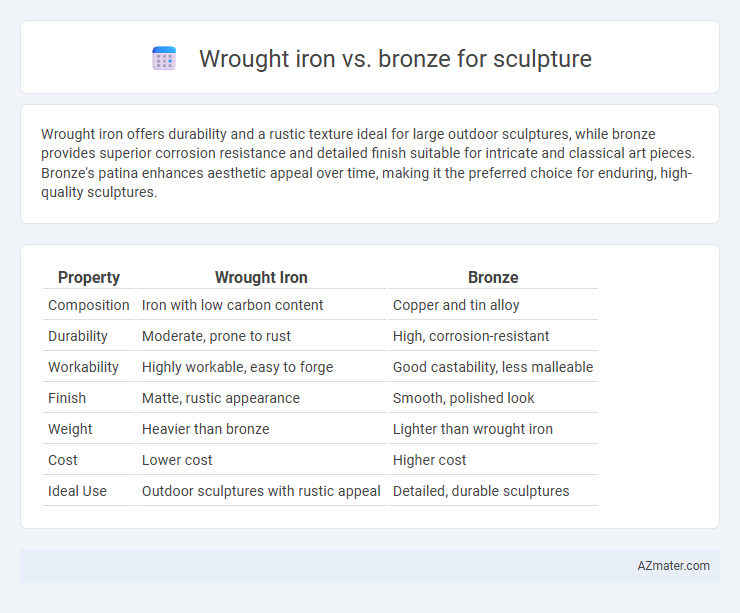Wrought iron offers durability and a rustic texture ideal for large outdoor sculptures, while bronze provides superior corrosion resistance and detailed finish suitable for intricate and classical art pieces. Bronze's patina enhances aesthetic appeal over time, making it the preferred choice for enduring, high-quality sculptures.
Table of Comparison
| Property | Wrought Iron | Bronze |
|---|---|---|
| Composition | Iron with low carbon content | Copper and tin alloy |
| Durability | Moderate, prone to rust | High, corrosion-resistant |
| Workability | Highly workable, easy to forge | Good castability, less malleable |
| Finish | Matte, rustic appearance | Smooth, polished look |
| Weight | Heavier than bronze | Lighter than wrought iron |
| Cost | Lower cost | Higher cost |
| Ideal Use | Outdoor sculptures with rustic appeal | Detailed, durable sculptures |
Introduction: Wrought Iron vs Bronze in Sculpture
Wrought iron and bronze differ significantly in sculptural applications due to their distinct physical properties and aesthetic qualities. Wrought iron offers malleability and a rustic, industrial look, ideal for larger, structural pieces, while bronze provides durability, corrosion resistance, and a classic, smooth finish preferred for fine details. Understanding these materials' characteristics influences the choice between wrought iron's strength and bronze's timeless elegance in sculpture creation.
Historical Significance of Wrought Iron and Bronze
Wrought iron has been historically significant in sculpture due to its durability, malleability, and widespread use during the Industrial Revolution, allowing for intricate, large-scale public artworks. Bronze, dating back to the Bronze Age, holds a monumental legacy in art for its corrosion resistance and ability to capture fine details, making it the preferred medium for classical and Renaissance sculptures. The enduring presence of both materials in public monuments and artistic heritage underscores their cultural and technological importance across civilizations.
Material Properties: Strength and Durability
Wrought iron exhibits high tensile strength and excellent durability due to its fibrous structure, making it resistant to cracking and impact damage in sculpture. Bronze offers superior corrosion resistance and better tensile and compressive strength, which enhances longevity, especially in outdoor environments. The choice between wrought iron and bronze depends on the required balance between strength, durability, and environmental exposure for the sculpture.
Visual Aesthetics: Finish and Texture Comparison
Wrought iron sculptures display a raw, industrial aesthetic with a matte or lightly weathered finish, offering a rugged texture that emphasizes handcrafted details and natural patinas. Bronze sculptures, renowned for their smooth, polished surfaces and warm golden to dark brown hues, provide a versatile finish ranging from glossy to richly patinated, which enhances fine details and depth. The choice between wrought iron and bronze significantly impacts the visual appeal, with wrought iron favoring a rugged, tactile presence, while bronze delivers refined elegance and intricate texture complexity.
Flexibility and Versatility in Artistic Design
Wrought iron offers exceptional flexibility due to its malleable nature, allowing artists to create intricate, dynamic forms with ease. Bronze, while less pliable, provides superior versatility through its ability to capture fine details in casting, making it ideal for complex and refined sculptures. The choice between wrought iron and bronze ultimately depends on whether the artist prioritizes structural adaptability or detailed precision in their design.
Techniques and Challenges in Sculpting Each Material
Wrought iron sculptures require mastering hot forging and welding techniques to manipulate its malleable yet tough composition, presenting challenges in preventing oxidation and ensuring structural integrity. Bronze casting involves precision in the lost-wax process, demanding careful temperature control and mold preparation to capture fine details, with difficulties including managing shrinkage and porosity during cooling. Both materials necessitate distinct expertise in handling their physical properties and overcoming environmental effects to achieve durable and detailed sculptures.
Maintenance, Longevity, and Corrosion Resistance
Wrought iron sculptures require regular maintenance to prevent rust, as they are prone to corrosion when exposed to moisture and air, and typically have a moderate lifespan if properly cared for. Bronze sculptures offer superior corrosion resistance due to the natural patina that forms on their surface, significantly enhancing their longevity and reducing the frequency of maintenance. The durable alloy composition of bronze ensures that sculptures maintain their structural integrity and aesthetic appeal over centuries, making it a preferred material for long-lasting outdoor artworks.
Cost Analysis: Affordability of Wrought Iron vs Bronze
Wrought iron is generally more affordable than bronze due to lower material costs and simpler fabrication processes, making it a cost-effective choice for large-scale sculptures. Bronze, an alloy of copper and tin, tends to be pricier because of its raw material expense and complex casting techniques required for detailed artwork. While bronze offers superior durability and aesthetic appeal, wrought iron provides a budget-friendly alternative with sufficient strength for many sculptural applications.
Environmental Impact and Sustainability
Wrought iron and bronze differ significantly in environmental impact and sustainability for sculpture. Wrought iron, primarily composed of iron with low carbon content, is recyclable and has a lower carbon footprint due to less energy-intensive production compared to bronze, an alloy of copper and tin with higher mining and smelting emissions. Bronze offers superior corrosion resistance and durability, reducing long-term maintenance and replacement, but the environmental cost of extracting copper and tin makes wrought iron the more eco-friendly choice for sustainable sculpture projects.
Choosing the Right Material for Your Sculpture Project
Wrought iron offers exceptional durability and rustic appeal, making it ideal for large outdoor sculptures exposed to harsh weather. Bronze provides superior detail, corrosion resistance, and a classic patina, preferred for intricate and long-lasting artworks. Selecting between wrought iron and bronze depends on the sculpture's intended environment, design complexity, and budget considerations.

Infographic: Wrought iron vs Bronze for Sculpture
 azmater.com
azmater.com